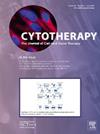Dialysis and lyophilization of the mesenchymal stromal cell secretome for wound healing
IF 3.7
3区 医学
Q2 BIOTECHNOLOGY & APPLIED MICROBIOLOGY
引用次数: 0
Abstract
Background aims
The clinical translation of mesenchymal stromal cell secretome (MSC-S) has been challenging owing to a lack of appropriate methods in downstream processing. Dialysis is an age-old method of protein purification by the exchange of small molecules through a semi-permeable membrane. In this study, we investigated the potential of three forms of umbilical cord–derived MSC secretome (UC-MSC-S)—native (S), dialyzed (DS), and lyophilized (LDS)—for wound healing applications.
Methods and Results
We dialyzed the UC-MSC-S using Slide-A-Lyzer G3 Dialysis Cassettes (20K MWCO) and then lyophilized it to obtain secretome powder. The DS fraction exhibited an 86.01-fold decrease compared with S, whereas LDS showed a 613.71-fold increase in the total protein concentration. Growth factor analysis revealed a significant decrease in the levels of interleukin-6 (IL-6; 54.44-fold), angiopoietin-1 (79.56-fold), angiopoietin-2 (51.76-fold), IL-8 (54.4-fold), platelet endothelial cell adhesion molecule-1 (PECAM-1; 63.25-fold), phosphatidylinositol glycan anchor biosynthesis class F (PIGF; 40.42-fold), vascular endothelial growth factor (VEGF; 39.64-fold), and tumor necrosis factor alpha (TNF-α; 24.62-fold) after dialysis as analyzed by the LEGEND plex multi-analyte flow assay kit on a FACS analyzer. Post-lyophilization, the levels of IL-6 (392.21-fold), angiopoietin-1 (823.04-fold), angiopoietin-2 (397.69-fold), IL-8 (584.83-fold), PECAM-1 (341.28-fold), PIGF (342.85-fold), VEGF (2209.42-fold), and TNF-α (194.4-fold) were enriched in LDS. The highest wound closure (64.07%) and a significant increase in angiogenesis were seen in DLS at the concentration of 1 µg/µL of protein by wound scratch and in ovo yolk sac membrane assay, respectively.
Conclusions
Dialysis followed by lyophilization is a simple and cost-effective method to fractionate and enrich the bioactive components of MSC-S without compromising the bioactivity for tailor-made applications.
伤口愈合间充质间质细胞分泌组的透析和冻干。
背景目的:由于缺乏合适的下游加工方法,间充质基质细胞分泌组(MSC-S)的临床翻译一直具有挑战性。透析是一种古老的蛋白质净化方法,通过半透膜交换小分子。在这项研究中,我们研究了三种形式的脐带源性间充质干细胞分泌组(UC-MSC-S)——原生(S)、透析(DS)和冻干(LDS)——在伤口愈合中的应用潜力。方法与结果:采用Slide-A-Lyzer G3透析磁带(20K MWCO)对UC-MSC-S进行透析,然后进行冻干,得到分泌组粉末。与S相比,DS组分的总蛋白浓度降低了86.01倍,而LDS组分的总蛋白浓度则增加了613.71倍。生长因子分析显示,白细胞介素-6 (IL-6)水平显著降低;54.44倍),血管生成素-1(79.56倍),血管生成素-2(51.76倍),IL-8(54.4倍),血小板内皮细胞粘附分子-1 (PECAM-1;63.25倍),磷脂酰肌醇聚糖锚定生物合成类F (PIGF;40.42倍),血管内皮生长因子(VEGF;39.64倍),肿瘤坏死因子α (TNF-α;24.62倍),在FACS分析仪上使用LEGEND plex多分析物流动检测试剂盒进行分析。冻干后,LDS中IL-6(392.21倍)、血管生成素-1(823.04倍)、血管生成素-2(397.69倍)、IL-8(584.83倍)、PECAM-1(341.28倍)、PIGF(342.85倍)、VEGF(2209.42倍)、TNF-α(194.4倍)水平显著升高。创面划痕法和卵黄囊膜法分别观察到蛋白浓度为1µg/µL时,DLS的创面闭合率最高(64.07%),血管新生率显著增加。结论:透析后冻干是一种简单、经济的分离和丰富MSC-S生物活性成分的方法,而不会影响其生物活性,适合定制应用。
本文章由计算机程序翻译,如有差异,请以英文原文为准。
求助全文
约1分钟内获得全文
求助全文
来源期刊

Cytotherapy
医学-生物工程与应用微生物
CiteScore
6.30
自引率
4.40%
发文量
683
审稿时长
49 days
期刊介绍:
The journal brings readers the latest developments in the fast moving field of cellular therapy in man. This includes cell therapy for cancer, immune disorders, inherited diseases, tissue repair and regenerative medicine. The journal covers the science, translational development and treatment with variety of cell types including hematopoietic stem cells, immune cells (dendritic cells, NK, cells, T cells, antigen presenting cells) mesenchymal stromal cells, adipose cells, nerve, muscle, vascular and endothelial cells, and induced pluripotential stem cells. We also welcome manuscripts on subcellular derivatives such as exosomes. A specific focus is on translational research that brings cell therapy to the clinic. Cytotherapy publishes original papers, reviews, position papers editorials, commentaries and letters to the editor. We welcome "Protocols in Cytotherapy" bringing standard operating procedure for production specific cell types for clinical use within the reach of the readership.
 求助内容:
求助内容: 应助结果提醒方式:
应助结果提醒方式:


